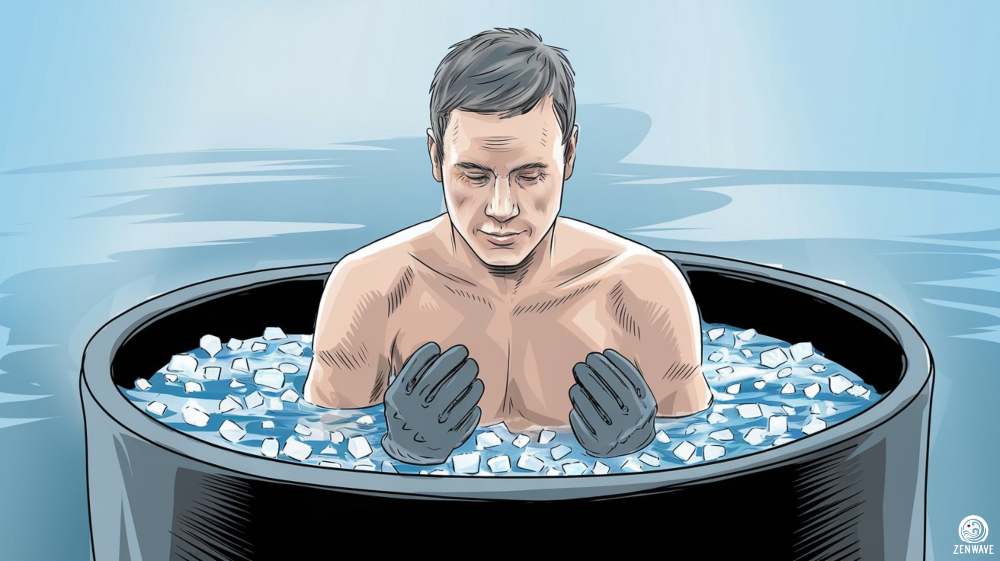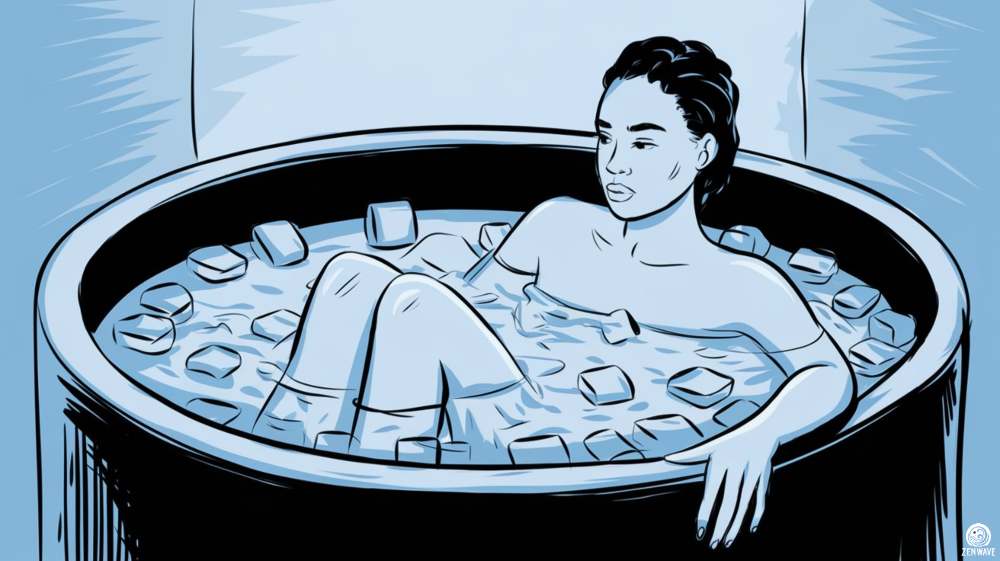Stepping into an ice bath is a big shock to the system, but with the right gear, it becomes a challenge you can embrace more comfortably. The cold is a key part of the experience, but choosing the right attire allows you to endure it safely while still reaping the full benefits of cold therapy.
At least a swim suit should be worn in an ice bath, but there are some other factors to consider. Some people may need to wear special swimsuits or additional protective gear if they have particular sensitivity to cold or conditions that requires extra caution.
This guide will help you navigate what to wear in an ice bath, ensuring you’re protected while staying true to the powerful effects of cold exposure.
Essential Clothing Items

Those into cold therapy want to harness the benefits of ice baths but while the goal is to expose your body to cold temperatures, basic coverage is still necessary. Let’s explore the essential clothing items for both men and women.
For Men: Tight-Fitting Swim Shorts
For men, the minimal piece of clothing for an ice bath is a pair of tight-fitting swim shorts. These provide basic protection while still allowing for maximum cold water exposure.
When selecting swim shorts for ice baths, consider the following:
Material: Ideally go for quick-drying fabrics like polyester or nylon.
Fit: Choose a snug fit to reduce water drag and prevent the shorts from becoming waterlogged.
Length: Mid-thigh to knee-length options offer a good balance of coverage and mobility.
The right swim shorts will stay in place during your ice bath, minimize discomfort, and allow you to focus on the benefits of the cold therapy. Remember, the goal is to find a balance between protection and exposure, so avoid overly baggy or loose-fitting shorts that can interfere with the cold water’s effects.
For Women: One-Piece or Two-Piece Bathing Suit
Women should at the minimum wear either a one-piece or two-piece bathing suit for ice bath sessions. Both styles have their advantages, and the choice often comes down to personal preference and comfort level.
One-piece swimsuits offer full torso coverage and a secure fit, which can be particularly appealing for those new to ice baths or preferring more coverage. On the other hand, two-piece bathing suits allow for more direct skin contact with the cold water and offer the flexibility to expose or cover the midsection as desired.
Regardless of the style chosen, here are key factors to consider:
Fit: Ensure a snug, supportive fit to prevent shifting during the ice bath.
Material: Look for quick-drying, chlorine-resistant fabrics for durability and comfort.
Comfort: Avoid suits with uncomfortable seams or fasteners that might irritate skin in the cold.
For both men and women, these basic clothing items serve as the foundation for your ice bath attire. They provide essential coverage while still allowing for an effective cold therapy experience. From this base, you can add additional protective gear like neoprene accessories if you desire more insulation for certain body parts.
Remember, the key is to find a balance between protection and exposure that allows you to comfortably challenge yourself in the ice bath while reaping its full benefits.
What to Wear for Enhanced Protection

For those seeking additional insulation during ice baths, neoprene offers great protection for those who need it. Neoprene, a synthetic rubber material commonly used in wetsuits, provides superior insulation while maintaining flexibility. Let’s explore neoprene options for both men and women.
Neoprene Shorts for Men
Neoprene shorts offer enhanced insulation compared to regular swim shorts, making them a popular choice among ice bath enthusiasts. They provide a good balance between protection and cold exposure.
Key considerations for neoprene shorts:
- Thickness: Available in 2mm to 5mm. Thicker neoprene offers more insulation but may reduce cold therapy effects slightly.
- Fit: Opt for a snug fit to maximize insulation and minimize water entry.
- Durability: Look for reinforced seams and high-quality neoprene for longevity.
Neoprene Swimsuits for Women
Women can choose from a variety of neoprene swimsuit options, ranging from full-body suits to shorts and top combinations. These suits offer comprehensive protection while still allowing for effective cold exposure.
When selecting a neoprene swimsuit, consider:
- Style: Choose based on personal preference and desired level of coverage.
- Thickness: Like men’s shorts, thicknesses vary. Select based on your cold tolerance and goals.
- Flexibility: Ensure the suit allows for comfortable movement during entry and exit from the ice bath.
Our extremities, particularly hands and feet, are often the first to feel the intense cold in an ice bath. Protecting these areas can significantly enhance comfort and can be very beneficial for those with bad circulation conditions that require extra care.
Neoprene Gloves
Neoprene gloves can be a game-changer for hand comfort during ice baths. They allow you to keep your hands submerged longer and provide a better grip on the sides of the tub or any objects you might need to hold.
Benefits of neoprene gloves:
- Cold protection
- Increased comfort
- Improved grip
- Various thicknesses available to suit your preference
Neoprene Socks
Like hands, feet are particularly sensitive to cold. Neoprene socks can help protect against numbness and improve your overall ice bath experience.
Advantages of neoprene socks:
- Protection against numbness in toes and feet
- Improved traction when entering or exiting the bath
- Available in different lengths, from ankle to knee-high, for varied protection
Head and Ear Protection
For those looking to fully immerse themselves or protect sensitive areas like the ears, a neoprene cap is an excellent addition to your ice bath gear.
Neoprene caps offer several benefits:
- Full head coverage, protecting the scalp from cold shock
- Built-in ear covers to prevent water entry
- Retention of body heat, as the head releases a significant amount of heat
By covering your head, you can help maintain your core temperature, potentially allowing for longer and more comfortable ice bath sessions.
What Not to Wear / Precautions

While we’ve covered what to wear in an ice bath, it’s equally important to understand what to avoid. Certain clothing choices can not only reduce the effectiveness of your ice bath but also pose potential safety risks.
1. Avoid Cotton Clothing
Cotton absorbs water readily and loses its insulating properties when wet. This can lead to:
- Increased discomfort during the ice bath
- Prolonged chilling effect after exiting the bath
- Potential for hypothermia in extreme conditions
Instead, stick to synthetic materials designed for water exposure, such as the neoprene options discussed earlier or quick-drying synthetic fabrics.
2. Remove Jewelry
Before entering an ice bath, it’s crucial to remove all jewelry. Here’s why:
- Metal conducts cold quickly, potentially causing localized discomfort or even mild frost nip
- Rings can be difficult to remove from cold, constricted fingers
3. Avoid Excessive Layering
While it might seem logical to wear multiple layers for warmth, this approach can be counterproductive in an ice bath:
- Too many layers can trap water, making it difficult to warm up afterwards
- Multiple layers can be cumbersome and affect mobility
4. Easy-to-Remove Clothing
When choosing your ice bath attire, prioritize items that are easy to put on and take off. This is important because:
- Your fingers may be cold and less dexterous after the bath
- Quick removal of wet clothing helps in the warming-up process
- In case of emergency, you need to be able to exit the bath and remove wet clothing quickly
Additional Considerations

1. Personal Comfort Preferences
Everyone’s tolerance for cold is different, and what works for one person may not work for another. Consider these factors:
- Your experience level with ice baths
- Any pre-existing health conditions
- Your body’s natural response to cold
It’s okay to start with more protection and gradually reduce it as you become more accustomed to the cold.
2. Duration of Ice Bath
The length of your ice bath session can influence your clothing choices:
- For shorter sessions (1-3 minutes), minimal protection may be sufficient
- Longer sessions (5+ minutes) might require additional insulation, especially for extremities
Remember to always listen to your body and exit the bath if you experience extreme discomfort or numbness. See our article “How Long To Stay in an Ice Bath” for more tips on durations for ice baths.
3. Water Temperature
The temperature of your ice bath can also impact your clothing decisions:
- Colder water (below 50°F/10°C) may require more protective gear
- Slightly warmer water (50-59°F/10-15°C) might allow for less coverage
Always measure the water temperature before entering and adjust your attire accordingly. For additional guidelines, chech out our guide on temperatures for ice baths.
Final Thoughts
Choosing the right clothes for an ice bath is a balance between embracing the challenge of cold exposure and protecting your body from potential risks. By following these guidelines, you can create a safe and effective ice bath experience tailored to your personal needs and goals.
Remember, the goal of an ice bath is to challenge your body safely. With the right clothing choices, you can maximize the benefits of cold therapy while minimizing discomfort and risk. As with any new health practice, consult with a healthcare professional before starting an ice bath regimen, especially if you have pre-existing health conditions.
For those ready to take the plunge into regular cold therapy, consider investing in an affordable, quality ice bath like the ZenWave Ice Pod. Its spacious design and durable construction provide an ideal environment for your ice bath sessions, regardless of your chosen attire. Whether you’re using minimal clothing for maximum cold exposure or opting for more protective neoprene gear, a well-designed ice bath tub can enhance your overall experience and help you maintain consistency in your cold therapy routine.

